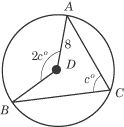Now we have a 30-60-90 triangle whose longer leg, AC, is also the
distance between lines l and m. Using the
1:2:v3 side ratios for 30-60-90 triangles you can use the hypotenuse length to
calculate the lengths of the other two legs. The short leg has a 1: 2 ratio to the hypotenuse, so its length is
5/2. The long leg has a v3 : 1 ration to the short leg, so its length is 5
v3 /2.
2.E
Let’s analyze each statement separately.
- This statement implies that DF = EF. We know that BF =
AF because it is given that line CF is the perpendicular bisector of
AB, and by definition, F is the midpoint of AB. It is also
given that the area of triangle CDB is equal to the area of triangle
CEA. These two triangles share the same height, and since the area of a
triangle is found by the formula 1/2 b ×
h, it follows that if their areas are equal, their bases are equal too.
If BD = AE, then by subtracting DE from each segment, we have
BE = AD and thus EF = DF. So statement I is true.
- This statement is simply not backed by any evidence. All we know is that BE
= AD, EF = DF, and BF = AF. As long as points
E and D are equidistant from F, all these conditions hold, so
there is no guarantee that they are the midpoints of BF and AF,
respectively. E and D could be anywhere along BF and AF,
respectively, as long as they are equidistant from F. Thus, this
statement is not necessarily true.
- Triangles CDB and CEA are equal in area; this is given. By
subtracting the area of triangle CED from each of these triangles, we see
that triangles CEB and CDA must have the same area. This statement
is true.
Only statements I and III must be true.
3.C
The area of a triangle with base x and height h is given by the
formula 1/2xh. The area of a square with sides of
length x is x2. Since you know the two shapes have
equal areas, you can set the two expressions equal to each other and solve for
h:
1/2
xh =
x2
xh = 2
x2
h = 2
x
The correct answer is h = 2x.
4.D
If ABD is an equilateral triangle, then AD = AB = BD
= 4, and all the sides of the rhombus have a length of 4 (by definition of a
rhombus, all sides are congruent). Also, by definition of a rhombus, opposite
angles are congruent, so < ABD = < ACD =60o.
Draw an altitude from a to DC to create a 30-60-90 triangle, and
from the length ratio of x : v3 x
: 2x among the sides, you can calculate the length of this altitude to be
2 v3 .The area of a rhombus is bh, so the area of this rhombus is 4
× 2 v3 = 8 v3 .
5.D
The length of the arc depends on the circumference of the circle and the measure
of the central angle that intercepts that arc. The formula is:
arc length =
n/360 × 2pr
where n is the measure of the central angle that intercepts the arc and
r is the radius.
Angle c is the inscribed angle or one-half as large as the central angle
that intercepts the circle at the same points. So the measure of this angle is 2cº.

Now simply plug the values into the formula: the length of arc AB is:
2c /360 × 2p(8) = 32cp /360 =4cp/45
Back
Next
Next to display next topic in the chapter.
Mathematics Practice Questions
Video Lessons and 10 Fully Explained Grand Tests
Large number of solved practice MCQ with explanations. Video Lessons and 10 Fully explained Grand/Full Tests.